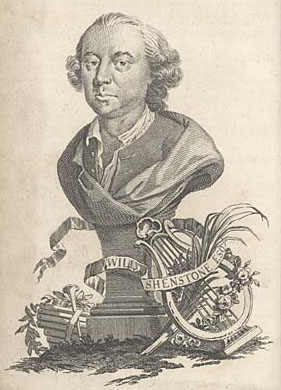| William Shenstone  Born: 18-Nov-1714 Born: 18-Nov-1714
Birthplace: Leasowes, Halesowen, Shropshire, England
Died: 11-Feb-1763
Location of death: Leasowes, Halesowen, Shropshire, England
Cause of death: unspecified
Gender: Male
Race or Ethnicity: White
Occupation: Poet Nationality: England
Executive summary: The Schoolmistress English poet, son of Thomas Shenstone and Anne, daughter of William Penn of Harborough Hall, Hagley, was born at the Leasowes, a property in the parish of Halesowen, now in Worcestershire, but then included in the county of Shropshire. At school he began a lifelong friendship with Richard Jago, and at Pembroke College, Oxford, where he matriculated in 1732, he made another firm friend in Richard Graves, the author of The Spiritual Quixote. He took no degree, but, while still at Oxford, he published for private circulation Poems on various occasions, written for the entertainment of the author (1737). This edition, containing the first draft of "The Schoolmistress", Shenstone tried hard to suppress, but in 1742 he published anonymously a revised form of The Schoolmistress, a Poem in imitation of Spenser.... The original was Sarah Lloyd, teacher of the village school where Shenstone received his first education. Isaac D'Israeli pointed out that it should not be classed, as it was by Robert Dodsley, as a moral poem, but that it was intended as a burlesque, to which Shenstone appended in the first instance a "ludicrous index." In 1741 he published The Judgment of Hercules. He inherited the Leasowes estate, and retired there in 1745 to undertake what proved the chief work of his life, the beautifying of his property. He embarked on elaborate schemes of landscape gardening which gave the Leasowes a wide celebrity, but sadly impoverished the owner. Shenstone was not a contented recluse. He desired constant admiration of his gardens, and he never ceased to lament his lack of fame as a poet.
Shenstone's poems of nature were written in praise of her most artificial aspects, but the emotions they express were obviously genuine. His Schoolmistress was admired by Oliver Goldsmith, with whom Shenstone had much in common, and his "Elegies" written at various times and to some extent biographical in character won the praise of Robert Burns who, in the preface to Poems, chiefly in the Scottish Dialect (1786), called him "that celebrated poet whose divine elegies do honor to our language, our nation and our species." The best example of purely technical skill in his works is perhaps his success in the management of the anapaestic trimeter in his "Pastoral Ballad in Four Parts" (written in 1743), but first printed in Dodsley's Collection of Poems (vol. iv., 1755). Shenstone died unmarried on the 11th of February 1763.
His works were first published by his friend Robert Dodsley (3 vols., 1764-69). The second volume contains Dodsley's description of the Leasowes. The last, consisting of correspondence with Graves, Jago and others, appeared after Dodsley's death. Other letters of Shenstone's are included in Select Letters, edited by Thomas Hill in 1778. The letters of Lady Luxborough (née Henrietta St John) to Shenstone were printed by T. Dodsley in 1775; much additional correspondence is preserved in the British Museum -- letters to Lady Luxborough (Add. MS. 28958), Dodsley's letters to Shenstone (Add. MS. 28959), and correspondence between Shenstone and Bishop Percy from 1757 to 1763 -- the last being of special interest; To Shenstone was due the original suggestion of Percy's Reliques, a service which would alone entitle him to a place among the precursors of the romantic movement in English literature.
Father: Thomas Shenstone
Mother: Anne
Risk Factors: Gout
Do you know something we don't?
Submit a correction or make a comment about this profile
Copyright ©2019 Soylent Communications
|